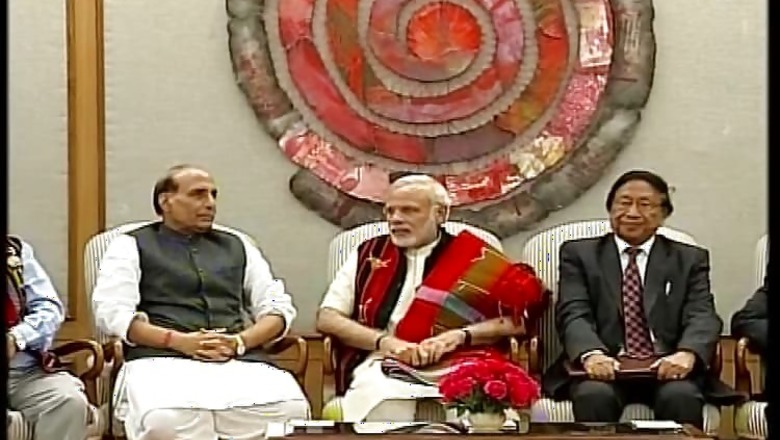
views
New Delhi: Naga insurgency is the oldest insurgency in the world. It started with the departure of the British from India. The Naga leaders never wanted to join the Union of India and wanted Nagaland to become an independent state. It did not happen. Nagaland was 'forced' to join the Union of India, as the first Prime Minister, Jawaharlal Nehru, was against an independent Naga nation.
The Naga militancy has seen several ups and downs since 1947. The major breakthrough happened during the more 'sympathetic' VP Regime in the 1989-90. The Naga leader in exile Angami Phizho was even able to return to Nagaland without accepting Indian passport. The VP Singh government fell, Phizho died and the Naga militants went back to the jungles.
The actual formal peace talks started only in 1997.
During AB Vajpayee's regime, the NSCN (IM) leaders returned to India and held the most fruitful talks with the Centre. Former Union home secretary K Padmanabhaiah was the interlocutor of the Centre then.
The NSCN (IM) leaders stayed back in India under government patronage and protection. After the Congress returned to power in 2004, senior Congress leader Oscar Fernandes was the emissary of the Centre. But the talks made no headway. During the run up to Lok Sabha elections, Narendra Modi visited Nagaland and promised an everlasting peace. He even campaigned there. The then Nagaland chief minister Rio joined the NDA and even won. Ironically Rio is nobody in Nagaland politics today.
According to a statement released by the government after Monday's deal, "This agreement will end the oldest insurgency in the country. It will restore peace and pave the way for prosperity in the North East. It will advance a life of dignity, opportunity and equity for the Naga people, based on their genius and consistent with the uniqueness of the Naga people and their culture and traditions."
Discussing the deal, a report in Nagaland's very influential daily 'Nagaland Post' says that against the backdrop of expectations raised by the legislators and hohos, about a likely early solution to the Naga political issue; questions are being raised on when would the ongoing talks between the Government of India and NSCN (IM) would finally conclude- within 2015 or 2016? The other crucial question being raised is-which state(s) would a likely solution be applicable-Nagaland or Manipur?
It may be recalled, that government Interlocutor to the Naga talks, RN Ravi had been reiterating, that the Naga political issue involves the Nagas and not only the NSCN (IM). Ravi had also made it clear, that all Nagas would be taken on board before finalising an agreement.
The DAN-III coalition government headed by TR Zeliang has an advantage since all political parties are part of the ruling alliance. The recently formed Nagaland Legislature Forum (NLF) comprises of all 60 members of the house.
As part of the DAN stand over the Naga political issue, Zeliang has been reiterating that the Naga political issue was a top priority for the government. As resolved in the July budget session, the Speaker convened a meeting with tribal hohos, students, women's organisations as part of a consultative process on July 31 in Jotsoma. The consultative meet reaffirmed the five-point assembly resolutions adopted on July 27.
What has been on the back of the Centre's mind remains the abrogation of cease fire by the NSCN (K) in April. According to reports, the Centre is conscious that any agreement that excludes any armed faction would render it incomplete. The dilemma of the Centre has been reflected in the statements of the union home ministry that all stakeholders- various NPGs and Naga tribal and civil society organisations need to be taken on board to ensure a permanent peace and solution acceptable to all sections.
Prime Minister Narendra Modi had purportedly stated that even if most of the demands were met, the remaining would have to be addressed; meaning a 100% solution was not going to be easy. The talks between the government of India and the NSCN (IM) has been spread over much of 18 years of cease fire and around 60 round of talks.
The applicability of an agreement appears to hinge on the response of the Manipur state government on giving autonomy to the Naga inhabited districts.
The Naga organisations of Manipur have been demanding an "alternative arrangement", a demand that has placed the Manipur government in a situation. However, it was yet to be made clear, even by Ravi whether the "alternative arrangement" meant full autonomy under an autonomous district council or a separate territory within a state.
According to a report in 'The Hindustan Times' last week, representatives of Naga civil society unanimously endorsed a five-point resolution passed by the Nagaland legislative assembly on July 27, including "integration of all contiguous Naga-inhabited areas".
Other resolutions included resumption of ceasefire between New Delhi and NSCN-Khaplang, which walked out of the peace process (inked in April 2001) on March 27 this year; and withdrawal of Armed Forces Special Powers Act of 1958 from Nagaland.
But Nagaland's neighbours in the northeast -- Arunachal Pradesh, Assam and Manipur - are wary of "integrating Naga-inhabited areas". These states view Greater Nagaland as a threat to their territorial integrity. They have witnessed violent protests, particularly in Manipur where a mob set the state assembly ablaze in 2001.
Will this deal would be able to address all these issues effectively? Will this also collapse in future? We certainly have no specific answers.
However what the Centre has done is a big step forward. If implemented properly, it can usher in a new era in Nagaland.




















Comments
0 comment